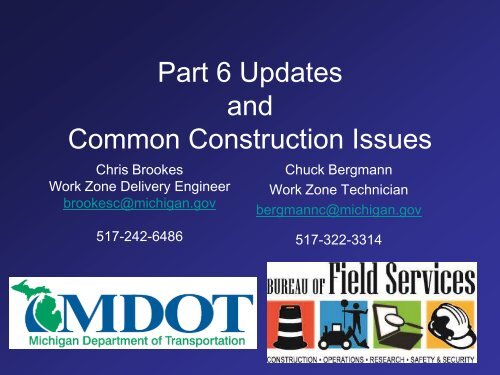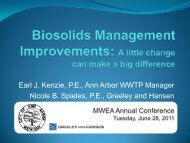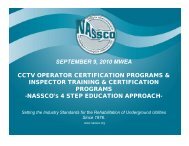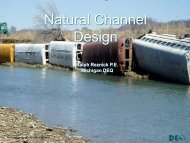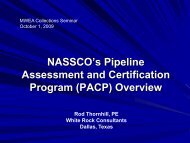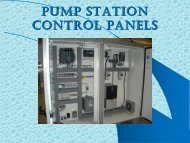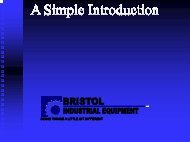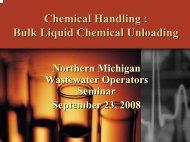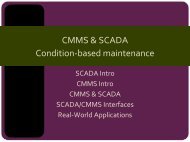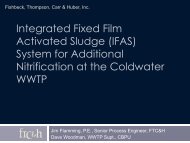Short-Term Stationary Work
Short-Term Stationary Work
Short-Term Stationary Work
Create successful ePaper yourself
Turn your PDF publications into a flip-book with our unique Google optimized e-Paper software.
Part 6 Updates<br />
and<br />
Common Construction Issues<br />
Chris Brookes<br />
<strong>Work</strong> Zone Delivery Engineer<br />
brookesc@michigan.gov<br />
517-242-6486<br />
Chuck Bergmann<br />
<strong>Work</strong> Zone Technician<br />
bergmannc@michigan.gov<br />
517-322-3314
www.michigan.gov/midashboard<br />
<strong>Work</strong> Zone<br />
Injuries &<br />
Fatalities
Crashes and Injuries<br />
Fatal and Incapacitating<br />
7000<br />
2011 Statewide <strong>Work</strong> Zone Crashes<br />
120<br />
6000<br />
100<br />
5000<br />
4000<br />
3000<br />
2000<br />
80<br />
60<br />
40<br />
1000<br />
20<br />
0<br />
2002 2003 2004 2005 2006 2007 2008 2009 2010 2011<br />
Year<br />
0<br />
Crashes Injuries Fatalities Incapacitating
Crash and Injuries<br />
Fatal and Incapacitating<br />
2011 Trunkline <strong>Work</strong> Zone Crashes<br />
5000<br />
4500<br />
90<br />
80<br />
4000<br />
3500<br />
3000<br />
2500<br />
2000<br />
1500<br />
1000<br />
500<br />
70<br />
60<br />
50<br />
40<br />
30<br />
20<br />
10<br />
0<br />
2002 2003 2004 2005 2006 2007 2008 2009 2010 2011<br />
Year<br />
0<br />
Crashes Injuries Fatalities Incapacitating
2011 <strong>Work</strong> Zone Related Crashes by Cause<br />
Other, 352<br />
Narrowing / Shifting Lanes,<br />
19<br />
Fail to Yield On Ramp, 56<br />
Slow / Yielding Traffic On<br />
Ramp, 57<br />
Debris in Roadway,<br />
113<br />
Slow / Stopping Traffic,<br />
992<br />
Late Taper<br />
Merge,<br />
134<br />
Hit Object, 159
2011 Non - <strong>Work</strong> Zone Related Crashes by Cause<br />
Other, 260<br />
Failure to Stop, 310<br />
Deer, 79<br />
Intoxicated, 31<br />
Hit Object, 60<br />
Disregarded Traffic Signal,<br />
63<br />
Lane Change, 209
<strong>Work</strong> Zone Policy<br />
Updates<br />
• 2011 Michigan MUTCD<br />
– December 1, 2011<br />
• Part 6<br />
– Effective April 1, 2012<br />
• MDOT <strong>Work</strong> Zone Safety and<br />
Mobility Policy Review<br />
– Currently ongoing
Part 6<br />
Temporary Traffic<br />
Control
Paragraphs are<br />
numbered!<br />
Guidance<br />
statements are<br />
italicized
Metric values have been removed<br />
from the text, figures, and tables<br />
• Only English units are used in the text, tables,<br />
and figures of the MMUTCD<br />
New Appendix<br />
A2 includes the<br />
equivalent<br />
metric values for<br />
all English units<br />
used in the<br />
MMUTCD
Minimum length for<br />
one-lane, two-way traffic<br />
taper added to Table 6C-3<br />
Type of Taper<br />
Merging Taper<br />
Shifting Taper<br />
Shoulder Taper<br />
One-Lane, Two-Way Traffic Taper<br />
Downstream Taper<br />
Taper Length<br />
at least L<br />
at least 0.5 L<br />
at least 0.33 L<br />
50 feet minimum, 100 feet maximum<br />
100 feet per lane
TAs with freeway lane closures<br />
- TAs 37, 38, 39, 42, and 44<br />
- Arrow board shall be used<br />
for all freeway lane<br />
closures<br />
- Separate arrow board shall<br />
be used for each closed<br />
lane for multi-lane closures
Better Roads – In Court<br />
• A motorcyclist crashes<br />
maneuvering over uneven lane<br />
heights in a construction zone.<br />
• Is the contractor to blame<br />
• Section 6F.45 UNEVEN<br />
LANES Sign (W8-11)<br />
• Guidance: The UNEVEN<br />
LANES (W8-11) sign (see<br />
Figure 6F-4) should be used<br />
during operations that create a<br />
difference in elevation between<br />
adjacent lanes that are open to<br />
travel<br />
• Jury found Failure to act fell<br />
below the standard of care for<br />
contractors.
New symbol<br />
sign and<br />
supplemental<br />
plaque for<br />
shoulder<br />
drop-off
New Alternating Diamond<br />
Merge Right<br />
Display to indicate Caution on<br />
an Arrow Board<br />
Merge Right or Left<br />
or<br />
or<br />
hing Caution Flashing Caution<br />
Alternating Diamond Caution<br />
Minimum Legibility<br />
Distance<br />
Minimum Number<br />
of Elements
TTC plan should be developed for<br />
planned special events that will<br />
impact traffic<br />
Bike race
<strong>Work</strong> Zone Safety and Mobility (WZSM) - News<br />
• Links for<br />
– System Operations Advisories<br />
(SOA’s)<br />
– Traffic and Safety Advisories<br />
– BOH – Instructional<br />
Memorandums<br />
– Construction Advisories (CA’s)<br />
• Sign Up for E-mail Alerts<br />
• Additional Links to Manuals and<br />
other <strong>Work</strong> Zone items<br />
• Google Title to find home<br />
page<br />
• http://www.michigan.gov/<br />
mdot/0,1607,7-151-<br />
9625_54944---,00.html
System Operations Advisories<br />
(SOA)<br />
• 2011-04 Channelizing Devices in <strong>Work</strong> Zones<br />
– 42” devices Maybe used in lieu of a standard cone for night work<br />
• 2011-06 Uniformed Law Enforcement in <strong>Work</strong> Zones<br />
– MDOT in cooperation with the FHWA, has established a guidance document for<br />
uniformered law enforcement in work zones<br />
• 2010-05 Traffic Regulating Instruction Manual<br />
– all regulators and supervisors are required to read the revised manual
<strong>Work</strong> Zone Safety<br />
• The MMUTCD, Part 6 states:<br />
– The primary function of TTC is to provide for<br />
the reasonably safe and efficient movement of<br />
road users through or around TTC zones<br />
while reasonably protecting workers,<br />
responders to traffic incidents, and<br />
equipment.
• Video 1
<strong>Work</strong> Zone Principles<br />
• Traffic control must be part of early project<br />
planning.<br />
• Disturb traffic as little as possible.<br />
• Guide motorists and pedestrians in a clear manner.<br />
• Change traffic control if not working.<br />
• Inspect devices and travel path for proper<br />
maintenance.<br />
• Train all people whose decisions affect the work<br />
zone.<br />
• <strong>Work</strong> zone enforcement.<br />
• Maintain good public relations.
• Video 2
Designing <strong>Work</strong> Zones<br />
• Balance Contractor needs vs. motorist<br />
needs vs. project cost<br />
• Be thorough in planning for traffic<br />
movements.<br />
• Include design for pedestrians.<br />
• Establish realistic speeds, minimize<br />
reductions.
Understanding the Motorist<br />
• The Motorist may also have physical<br />
limitations or reduced skills:<br />
– Poor vision<br />
– Reduced reaction time<br />
– Medications<br />
– Distracted driving
• <strong>Work</strong>er Visibility Final<br />
Rule put into effect for<br />
federal aid roadways<br />
Nov. 24, 2008<br />
• 2011 MMUTCD<br />
High Vis Clothing<br />
Changed to all roadways,<br />
Compliance date<br />
Dec. 31, 2011
…but they must also be in good<br />
shape…
..the Good, the Bad, and the Ugly…
<strong>Work</strong>er Safety Considerations -<br />
Lighting<br />
Where nighttime work is performed the work<br />
location shall be lighted per the:<br />
– 2012 Spec Book 812.03.H<br />
– MIOHSA General Rule R408.40133
Night Time Lighting
See the excavator and truck
Find the 2 workers…
He’s just to<br />
the right of<br />
the 3 small<br />
lights.<br />
Can You See the <strong>Work</strong>er
“Gamma”<br />
adjusted<br />
on digital<br />
photo<br />
Now – can you see the worker
Things to think about…<br />
• Ease of use for the workers<br />
• Integral to the truck<br />
• Impact to motoring public<br />
– Glare / Angle of lights<br />
– Too many flashing amber lights may be too much<br />
• Lighting should help the workers see and be<br />
seen.<br />
• Is there a light meter available to check
<strong>Work</strong> Zone “Defined”<br />
• “<strong>Work</strong> zone” means a portion of a street or<br />
highway that meets any of the following:<br />
(a) Is between a “work zone begins” sign and an<br />
“end road work” sign.<br />
(b) For construction, maintenance, or utility work<br />
activities conducted by a work crew and more than<br />
1 moving vehicle, is between a “begin work<br />
convoy” sign and an “end work convoy” sign.
<strong>Work</strong> Zone “Defined”<br />
• (c) For construction, maintenance, surveying, or utility work activities<br />
conducted by a work crew and 1 moving or stationary vehicle<br />
exhibiting a rotating beacon or strobe light, is between the following<br />
points:<br />
• (i) A point that is 150 feet behind the rear of the vehicle or that is the<br />
point from which the beacon or strobe light is first visible on the<br />
street or highway behind the vehicle, whichever is closer to the<br />
vehicle.<br />
• (ii) A point that is 150 feet in front of the front of the vehicle or that is<br />
the point from which the beacon or strobe light is first visible on the<br />
street or highway in front of the vehicle, whichever is closer to the<br />
vehicle.
<strong>Work</strong> Duration<br />
Section 6G.02<br />
• A. Long term stationary is work that occupies a location<br />
more than 3 days<br />
• B. Intermediate-term stationary is work that occupies a<br />
location more then one daylight period up to 3 days, or<br />
nighttime work lasting more than 1 hour.<br />
• C. <strong>Short</strong>-term stationary is daytime work that occupies a<br />
location for more than 1 hour with in a single daylight<br />
period.<br />
• D. <strong>Short</strong> Duration is work that occupies a location up to 1<br />
hour<br />
• E. Mobile is work that moves intermittently or<br />
continuously.
<strong>Work</strong> Duration<br />
• (A) Long term and (B) Intermediate-term require<br />
retroreflective and/or illuminated devices shall be used.<br />
• (C) <strong>Short</strong>-term stationary (D) <strong>Short</strong> duration – devices<br />
having greater mobility might be used, but safety should<br />
not be compromised by using fewer devices.<br />
– The increased hazards can justify the reduction in the<br />
number of devices if this is offset by the use of other<br />
more dominant devices.<br />
• (E) Mobile – shall have appropriate devices on<br />
equipment, or use a separate vehicle with the<br />
appropriate warning devices.
Definitions<br />
• Long-<strong>Term</strong> <strong>Stationary</strong> <strong>Work</strong><br />
Support:<br />
• At long-term stationary work zones, there is ample time to install and realize benefits<br />
from the full range of temporary traffic control procedures and devices that are<br />
available for use. Generally, larger channelizing devices, temporary roadways, and<br />
temporary traffic barriers are used.<br />
Guidance:<br />
• Inappropriate markings in long-term stationary work zones should be removed and<br />
replaced with temporary markings.<br />
Standard:<br />
• Since long-term operations extend into nighttime, retro reflective and/or illuminated<br />
devices shall be used in long-term stationary work zones.
Intermediate <strong>Work</strong><br />
• Intermediate-<strong>Term</strong> <strong>Stationary</strong> <strong>Work</strong><br />
Support:<br />
• In intermediate-term stationary work zones, it might not be feasible or practical to use<br />
procedures or devices that would be desirable for long-term stationary temporary<br />
traffic control zones, such as altered pavement markings, temporary traffic barriers,<br />
and temporary roadways.<br />
• The increased time to place and remove these devices in some cases could<br />
significantly lengthen the project, thus increasing exposure time. In other instances,<br />
there might be insufficient payback time to economically justify more elaborate<br />
temporary traffic control measures.<br />
Standard:<br />
• Since intermediate-term operations extend into nighttime, retroreflective and/or<br />
illuminated devices shall be used in intermediate-term stationary work zones.
<strong>Short</strong>-<strong>Term</strong> <strong>Work</strong><br />
• <strong>Short</strong>-<strong>Term</strong> <strong>Stationary</strong> <strong>Work</strong><br />
• Support:<br />
• Most maintenance and utility operations are short-term<br />
stationary work.
<strong>Short</strong> Duration<br />
<strong>Short</strong>-Duration <strong>Work</strong><br />
• As compared to stationary operations, mobile and short-duration operations are activities that<br />
might involve different treatments. Devices having greater mobility might be necessary such as<br />
signs mounted on trucks. Devices that are larger, more imposing, or more visible can be used<br />
effectively and economically. The mobility of the work zone is important. Maintaining reasonably<br />
safe work and road user conditions is a paramount goal in carrying out mobile operations.<br />
Guidance:<br />
• Safety in short-duration or mobile operations should not be compromised by using fewer devices<br />
simply because the operation will frequently change its location.<br />
Option:<br />
• Appropriately colored or marked vehicles with high-intensity rotating, flashing, oscillating, or strobe<br />
lights may be used in place of signs and channelizing devices for short-duration or mobile<br />
operations. These vehicles may be augmented with signs or arrow panels.<br />
Support:<br />
• During short-duration work, it often takes longer to set up and remove the work zone than to<br />
perform the work. <strong>Work</strong>ers face hazards in setting up and taking down the work zone. Also, since<br />
the work time is short, delays affecting road users are significantly increased when additional<br />
devices are installed and removed.
<strong>Short</strong> Duration<br />
• Option:<br />
• Considering these factors, simplified control procedures<br />
may be warranted for short-duration work.<br />
• A reduction in the number of devices may be offset by<br />
the use of other more dominant devices such as high<br />
intensity rotating, flashing, oscillating, or strobe lights on<br />
work vehicles.
<strong>Work</strong> Zone Typicals<br />
• http://www.michigan.gov/mdot<br />
– Click on “Maps and Publications” on the left<br />
side of the page<br />
– Click on “Traffic Standards and Typicals”<br />
under Plans & Specifications<br />
– Click on <strong>Work</strong> Zones on left side of the page.<br />
OR<br />
http://mdotwas1.mdot.state.mi.us/public/tands/p<br />
lans.cfm
Maintenance <strong>Work</strong> Zone Traffic<br />
Control Guidelines<br />
• http://www.michigan.gov/documents/zonecontrol_112912_7.pdf
Construction<br />
Tools to Improve Safety
NTCIP Compliant PCMS<br />
• Post timely incident<br />
management<br />
response messages<br />
• Current and accurate<br />
construction<br />
scheduling messages<br />
• Real time traveler<br />
information<br />
• SOA – 2012-01
Signing
Signing
Common Issues
Correct
Type III<br />
Details
Evaluation of TTC
Retroreflective
6F.67 Drums<br />
• Minimum of 36” in height<br />
• Marking shall be horizontal<br />
alternating orange and white<br />
stripes 4” to 6” wide, with the top<br />
stripe being orange.<br />
• MDOT requires 6” wide stripes<br />
• Minimum 2 orange and 2 white<br />
stripes
Cover Existing Signs
Cover Existing Signs<br />
812.03.D.2<br />
•Do not use sign plaque overlays that alter part<br />
of the legend or symbol.<br />
For temporary signs on fixed supports, cover the<br />
entire sign legend<br />
Do not use burlap or similar material to cover<br />
Department owned signs. The Contractor may<br />
use soft covers on other temporary signs.
Sign Covers
Do you see a problem
Sign Placement
Pavement markings<br />
&<br />
Temporary Signing
Ballasting<br />
WZD-125 - SIGN STAND IS BALLASTED WITH FOUR OR MORE 35<br />
LB SANDBAGS. A MINIMUM OF ONE ON EACH END
Bottom Heights
• For locations with<br />
guardrail, if conditions<br />
require temporary<br />
removal of temporary<br />
signs on portable<br />
supports, remove the sign<br />
stands from the uprights.<br />
Lay the sign behind the<br />
guardrail, and place<br />
support stands and<br />
ballasts close to the<br />
guardrail<br />
Sign Storage<br />
812.03.D.1
Construction equipment interfering<br />
with traffic
Construction Equipment in Traffic<br />
Section 257 – 62, 216, 302<br />
• Michigan Vehicle Code<br />
257.688<br />
– An equilateral triangle in<br />
shape, at least 16 inches wide<br />
at the base and at least 14<br />
inches in height: with a dark<br />
red border, at least 1-3/4<br />
inches wide of highly reflective<br />
beaded material<br />
– A center triangle, at least 12-<br />
1/4 inches on each side of<br />
yellow-orange fluorescent<br />
material<br />
• Shall be mounted on the rear of<br />
the vehicle, broad base down, not<br />
less than 3 feet nor more than 5<br />
feet above the ground and as near<br />
the center of the vehicle as<br />
possible.
<strong>Work</strong>er<br />
Behavior<br />
• How do<br />
you like<br />
the worker<br />
position in<br />
relation to<br />
the<br />
cones
• Do you<br />
like this<br />
position<br />
better<br />
<strong>Work</strong>er Behavior
• What do you think about the worker’s position – in the live lane of<br />
traffic<br />
• (Think maybe the arrow board is pointing drivers to him)
<strong>Work</strong>er Behavior – Standing on Walls
When <strong>Work</strong>ing Near Traffic…Your<br />
Responsibilities<br />
• Think Safety at all times.<br />
• Assume all lanes are open to traffic.<br />
• Never assume that traffic sees you.<br />
• Never assume that the driver is driving<br />
safely.<br />
• Pay attention to work equipment and<br />
operators.
When <strong>Work</strong>ing Near Traffic…Your<br />
Responsibilities<br />
• Always look and listen.<br />
• Do not walk side by side.<br />
• Know where you are at all times.<br />
• Always try to have an escape path.<br />
• When possible, work with a traffic spotter.<br />
• When possible do not turn your back to<br />
traffic.
<strong>Work</strong>ing near Traffic
<strong>Work</strong>ing near Traffic
Questions<br />
• Chris Brookes<br />
• BrookesC@michigan.gov<br />
• Cell: 517-242-6486<br />
• Desk: 517-636-0300<br />
• Chuck Bergmann<br />
• BergmannC@michigan.gov<br />
• Cell: 517-388-5228<br />
• Desk: 517-322-3314


